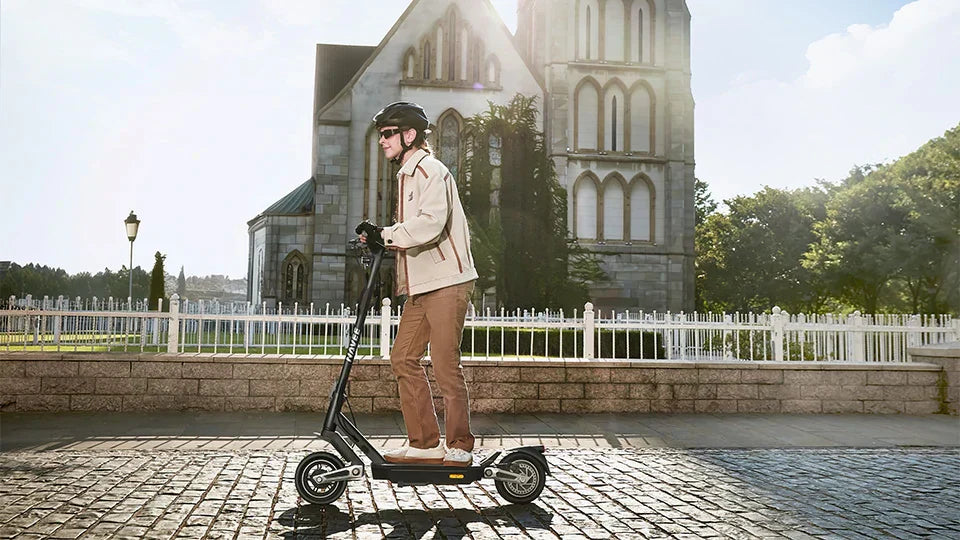When shopping for a new ride, you might wonder: Are e-bikes and e-scooters the same? The answer is no—while both are electric and eco-friendly, they have very different designs, features, and legal rules. This guide will break down what sets e-bikes and e-scooters apart, their pros and cons, and how to choose the right one for your needs.
What Is an E-Bike?
An electric bike, or e-bike, looks and rides much like a traditional bicycle but includes an electric motor to help with pedaling. E-bikes are great for longer commutes, uphill climbs, or anyone who wants a little boost without the sweat. You sit while riding, can use pedals, and most e-bikes come with adjustable pedal assist or a throttle. Many cities allow e-bikes in bike lanes, and you can cover longer distances comfortably.
Key Features of Electric Bikes
• Pedal Assist: Lets you ride further and tackle hills with ease.
• Longer Range: Most electric bikes can travel 20–60 miles per charge.
• Seated Comfort: Enjoy a stable, seated ride, great for longer journeys.
• Road Versatility: Suitable for bike lanes, roads, and even some light trails.
• Cargo-Friendly: Many models support racks for groceries, bags, or even kids.
What Is an E-Scooter?
An electric scooter (or e-scooter) is a stand-up device with handlebars, a compact motor, and a simple throttle for acceleration. E-scooters are lightweight, foldable, and perfect for short city trips or last-mile commuting. You stand while riding and control your speed with the handlebars. Many riders choose e-scooters for their portability and fun, quick rides.
Best E-Scooter for Urban Commuters: NAVEE ST3 Pro
If you're searching for a reliable and high-tech e-scooter, the NAVEE ST3 Pro stands out in the market.
• Powerful Motor: With a 1350W motor, it delivers rapid acceleration and handles city slopes with ease.
• Advanced Comfort: The Damping Arm™ patented suspension absorbs bumps, while 10-inch self-sealing tubeless tires ensure a smooth ride.
• Safety First: Triple braking system (drum, disc, EABS) and integrated lighting give you confidence in traffic and at night.
• Smart and Portable: Foldable for easy storage, with app integration and anti-theft features for daily convenience.
E-Bike vs E-Scooter: What’s the Real Difference?
Design & Riding Style
• E-Bike features a seated position, pedals for propulsion, and larger wheels for a smoother ride.
• E-Scooter is designed for a stand-up riding position, with no pedals, smaller wheels, and a lighter overall weight.
Speed & Range
• E-Bikes often reach speeds of 15–28 mph with longer ranges.
• E-Scooters usually top out at 15–25 mph with a range from 10–40 miles, depending on the model. (The NAVEE ST3 Pro electric scooter boasts a top speed of 24.9 mph and a maximum range of up to 46.6 miles, making it an excellent choice for urban commuting and leisure rides.)
Use Case & Portability
• E-Bikes are better for longer commutes, carrying cargo, or comfort over distance.
• E-Scooters shine for quick trips, last-mile connections, and easy storage at home or the office.
Curious about how folding designs make e-scooters even more convenient for daily city life? Check out our Ultimate Guide to Folding Electric Scooters in 2025 for practical tips and top model recommendations.
Legal & Safety Considerations
• E-Bikes may need helmets, age restrictions, or registration in some areas—always check local rules.
• E-Scooters also have local regulations, often requiring helmets for minors and restricting where you can ride.
Tip: Always check your city or state’s most recent laws for both vehicles before riding.
Which One Should You Choose?
If you need a comfortable ride for longer trips, or want an affordable, energy-efficient way to get around, an electric bike is a great solution. E-bikes offer smooth pedal assist, good range, and extra comfort for commuting or running errands—even on hills or longer distances. For more choices, check out a selection of electric bikes here.
If city convenience, speed, and portability are your priorities, the NAVEE ST3 Pro e-scooter is hard to beat. Its powerful 1350W motor and patented Damping Arm™ suspension system deliver smooth, stable rides even over rough city streets. With up to 46.6 miles of range, triple braking, fast folding, and self-sealing tires, the ST3 Pro is a smart choice for reliable, comfortable urban commuting.
FAQ
Q1: Can I ride both in bike lanes?
A: In many cities, yes—but rules vary. E-bikes are more widely accepted in bike lanes, while some areas restrict e-scooters to roads or specific paths.
Q2: Which is easier to maintain?
A: E-scooters generally need less maintenance due to their simple design. E-bikes, with more moving parts, may require occasional tune-ups like a regular bicycle.
Q3: Do I need a license or insurance?
A: Most areas don’t require a license or insurance for either, but check local laws, as some places do have restrictions or age minimums.
Q4: Which is better for hilly cities?
A: E-bikes handle hills more easily, thanks to pedal assist and higher torque. Some powerful e-scooters, like the ST3 Pro, can also tackle slopes well.
Conclusion
E-bikes and e-scooters are both fantastic, eco-friendly options for urban travel—but they’re not the same. Electric bikes offer range and comfort, while e-scooters provide speed, portability, and fun for city living. Decide what fits your daily needs, always check local regulations, and choose a model with proven performance.
Ready to make your commute smarter? Check out the NAVEE ST3 Pro e-scooter for a high-tech, comfortable, and reliable urban ride.








Share:
Do You Need A License for An Electric Scooter?
Best Commuter Scooter by NAVEE: Top Electric Scooters for Urban Commuting